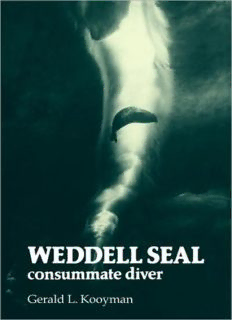
Weddell Seal: Consummate Diver PDF
Preview Weddell Seal: Consummate Diver
WEDDELL SEAL, CONSUMMATE DIVER WEDDELL SEAL consummate diver GERALD L. KOOYMAN Physiological Research Laboratory, Scripps Institution of Oceanography CAMBRIDGE UNIVERSITY PRESS Cambridge London New York New Rochelle Melbourne Sydney CAMBRIDGE UNIVERSITY PRESS Cambridge, New York, Melbourne, Madrid, Cape Town, Singapore, Sao Paulo, Delhi Cambridge University Press The Edinburgh Building, Cambridge CB2 8RU, UK Published in the United States of America by Cambridge University Press, New York www.cambridge.org Information on this title: www.cambridge.org/9780521112413 © Cambridge University Press 1981 This publication is in copyright. Subject to statutory exception and to the provisions of relevant collective licensing agreements, no reproduction of any part may take place without the written permission of Cambridge University Press. First published 1981 This digitally printed version 2009 A catalogue record for this publication is available from the British Library Library of Congress Cataloguing in Publication data Kooyman, Gerald L Weddell seal, consummate diver. Includes index. 1. Weddell seal. 2. Mammals - Antarctic regions- McMurdo Sound. I. Title. QL737.P64K66 599.74'8 80-18794 ISBN 978-0-521-23657-7 hardback ISBN 978-0-521-11241-3 paperback Contents Preface vii 1 McMurdo Sound 1 2 The Weddell seal 13 3 Breeding, birth, and growth 20 4 Cold 30 5 Diving behavior: Poseidon's pride 40 6 Physiology of diving 52 7 Food habits and energetics 75 Under-ice orientation (summer day-winter night) 86 9 Distribution, abundance, and mortality 109 10 Future prospects 121 References 127 Index 132 Preface In recent years, several fine books have been published that are de- voted to comprehensive, life-history accounts of single, terrestrial, mammalian species. The major tools for these studies were notebook, binoculars, and keen observation. The complexity of the sea and the size of some marine mammals present insurmountable obstacles to comprehensive studies. Un- derwater visibility in the sea is seldom good enough to see from one end of some of the larger whales to the other; obviously, the obser- vational tools in the sea, as in most natural situations, must be complex. However, there is one place where an unusual set of circumstances has reduced the complexities of such studies and provided us with a window into the underwater world. It is one of the most isolated wildernesses on earth: McMurdo Sound, Antarc- tica. During most of the year, this is the exclusive kingdom of the Weddell seal. Nowhere else, not even in other parts of Antarctica, is it possible to observe and study Weddell seals or any other sea mammal in such detail as here. Yet, paradoxically, the characteristics that make this place so suitable for scientists to observe seals also make it one of the most difficult places for a sea mammal to survive. What we have learned about the Weddell seals in this area seems to justify this contention. The information obtained at times borders on the sensational. By extrapolation, it also has given us new insight into other marine mammals and how extraordinary their life patterns must be. It is my goal in this book to give the lay public, undergraduate and graduate students, and my peers a comprehensive description of viii Preface some of the remarkable characteristics and habits of this species; and to do it within a single work. This has not been done before. In my effort to satisfy such a broad audience, I hope that the book will not seem overly detailed in some cases, or so simple in others that read- ers will lose interest in the whole. If my objective is achieved, then I feel that not only will the public's world be enlarged, but some part of my debt to Weddell seals will be repaid. I am indebted to many for assisting in the work, and for giving advice and support. Financial aid that made the various studies pos- sible has come from the Division of Polar Programs of the National Science Foundation and from the Heart and Lung Institute of the National Institutes of Health. The former is also responsible for a tremendous logistic program, which makes all field projects possible. The people who have helped me over the more than fifteen years of my fascination with Weddell seals are too numerous to acknowledge individually. Some are mentioned in the book. To the others, I say that omission does not reflect any less gratitude on my part. I must make two exceptions: Dr. George A. Llano, who at the inception of my research said it was possible, and Professor Albert R. Mead, who was willing to extend the Arizona horizon to Antarctica. G. K. To vivacious, enthusiastic Melba: Always present in spirit, but for whom Antarctica has been a vicarious experience
Description: